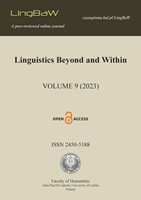Automatically generated language learning exercises for Finno-Ugric languages
Automatically generated language learning exercises for Finno-Ugric languages
Author(s): Zsanett FerencziSubject(s): Foreign languages learning, Language acquisition, Sociology of Education
Published by: Wydawnictwo KUL
Keywords: natural language processing; computer-assisted language learning; virtual flashcards; Finno-Ugric languages;
Summary/Abstract: Morphologically rich languages always constitute a great challenge for language learners. The learner must be able to understand the information encoded in different word forms of the same root and to generate the correct word form to express certain syntactic functions and grammatical relations by conjugating a verb or declining a noun, an adjective or a pronoun. One way to improve one’s language skills is through exercises that focus on certain aspects of grammar. In this paper, a language learning application is presented that is intended to help learners of Finnish and Hungarian (with Hungarian and Finnish L1, respectively) acquire new vocabulary items, as well as practice some grammar aspects that according to surveys are considered difficult by learners of these languages with the other Finno-Ugric language being the learner’s native tongue, while alleviating the need to create these exercises manually. This application is a result of an on-going research project. In this research project, bilingual translation pairs and additional monolingual data were collected that can be utilized to build language learning exercises and an online bilingual dictionary with the help of automatic methods. Several linguistic patterns and rules were defined in order to automatically select example sentences that focus on a given part of the target language. These sentences were automatically annotated with the help of language processing tools. Due to the large size of the previously collected data sets, to date, only a subset of the analyzed sentences and the bilingual translation pairs has been manually evaluated. The results of this evaluation are discussed in this paper in order to estimate the precision of the methodology presented here. To ensure the precision of the information and the reliability of the application, only manually validated data sets are displayed. In this project, continuous data validation is planned, since it leads to more and more examples and vocabulary items that learners can benefit from.
Journal: Linguistics Beyond and Within (LingBaW)
- Issue Year: 9/2023
- Issue No: 9
- Page Range: 23-35
- Page Count: 13
- Language: English

